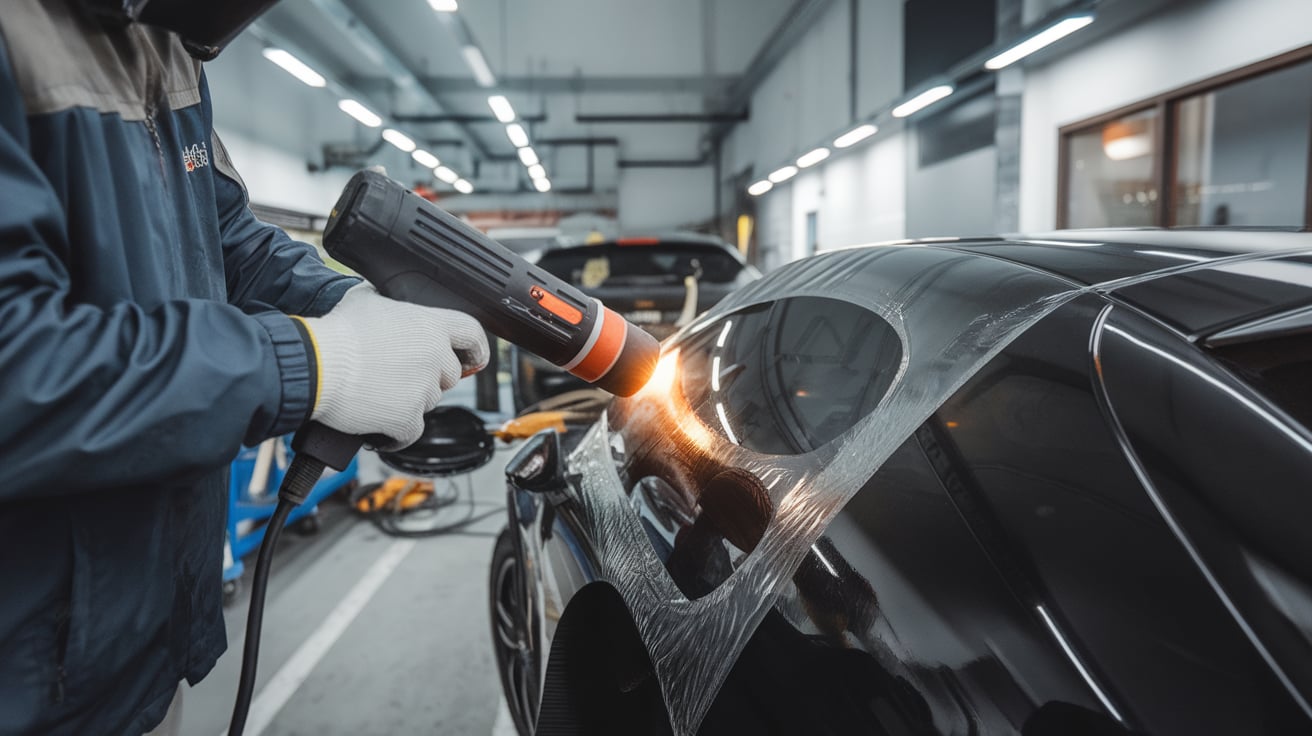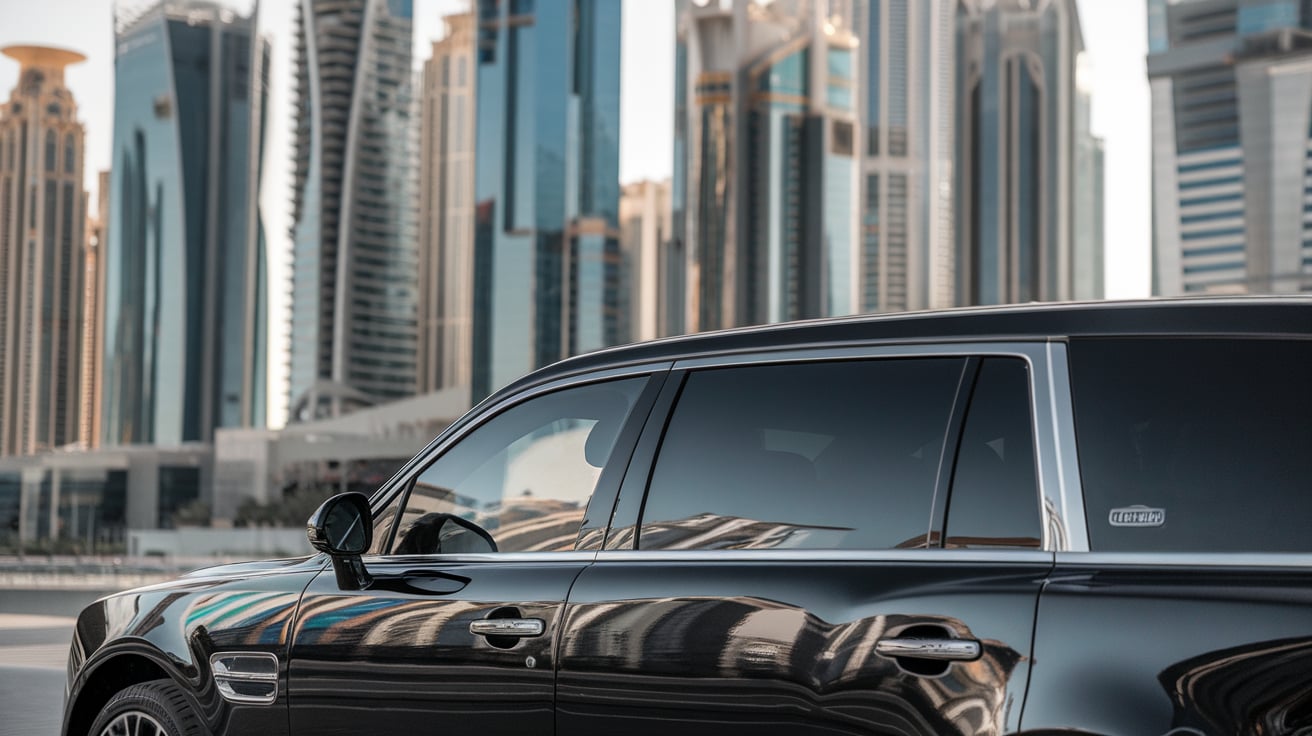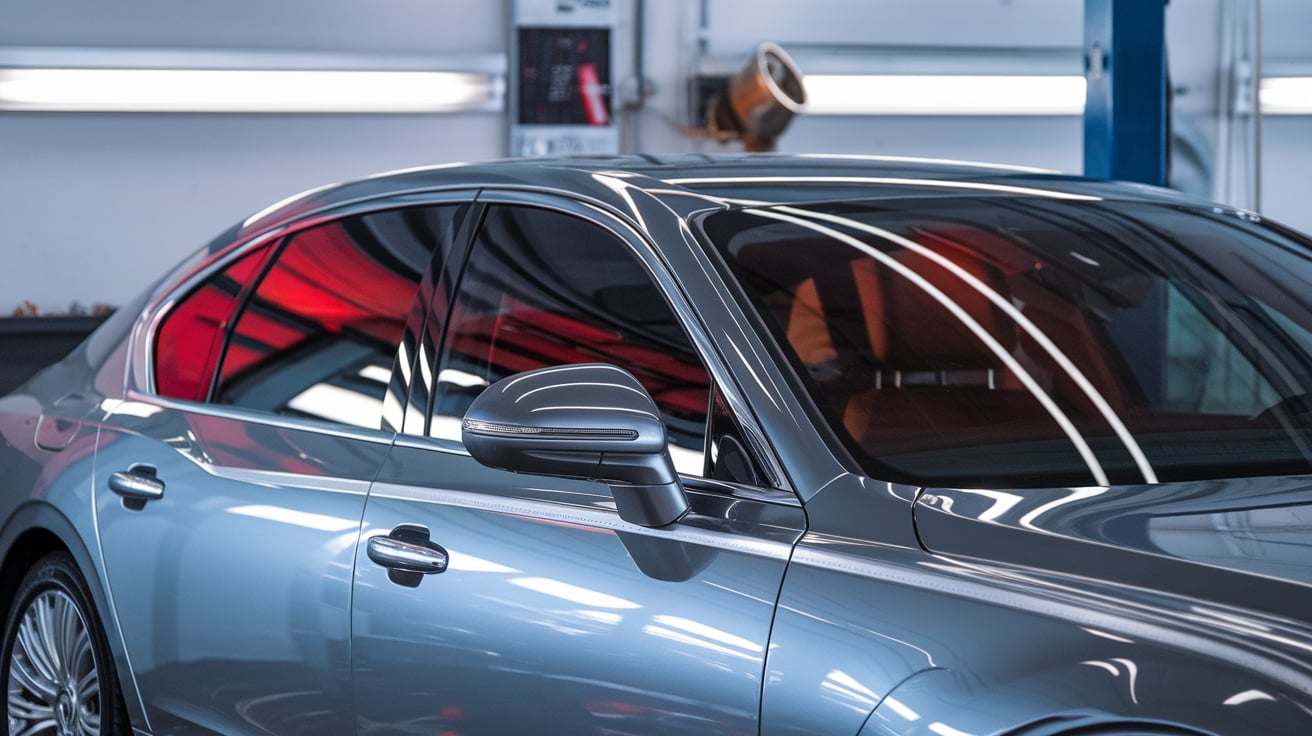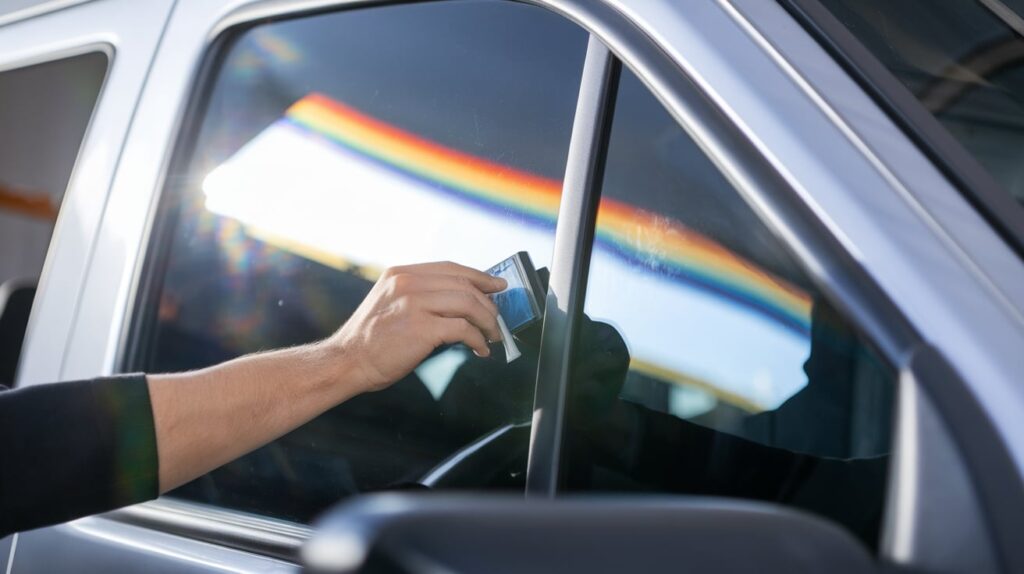Ever tried shrinking tint film and ended up with those annoying creases or uneven spots? Happens more than anyone likes to admit. Whether you’re using a heat gun or an IR lamp, the way heat hits that film can make or break the finish. Some say a heat gun gives better control, others swear by the steady warmth of infrared. But which one actually shrinks tint film more evenly? If you’re working under Dubai’s harsh sun, your choice matters even more. Let’s dig into it, no fluff, just real-world experience.
How Tint Film Reacts to Heat
When you apply heat to window tint, it is not just about making it stick. It is about how the film moves, shrinks, and settles onto the glass. A lot can go wrong if you do not know how it behaves under heat. Here is what really happens when tint film meets heat:
- Polyester reacts to heat by contracting
Most car window tints are made of polyester. When heated, it tightens up, pulling the film into shape. Too much heat though, and it might wrinkle or melt. - The adhesive softens to help bonding
As you heat the tint, the glue layer becomes sticky. This helps it grip the glass better and eliminate air gaps. But if you overdo it, it can smear or slide. - Heat allows contouring over curves
On curved windows, like rear windshields, you need the film to stretch and shrink precisely. Heat lets you shape it smoothly over the glass. - Excessive heat causes burns or bubbles
Using a heat gun or IR lamp for too long in one spot will overcook the film. That’s when you get burns, bubbles, or even cracking. - Different films react at different rates
Dyed film, metalized, ceramic, they all shrink differently. Some films need more heat, some less. IR lamps work best for slow, even shrinking. Heat guns need a trained hand. - Film memory matters
Good-quality tint has “memory”, when you heat and stretch it, it returns to its original form. That’s useful when adjusting or shrinking edges. - Humidity and temperature also affect the shrink
In Dubai’s climate, heat outside the garage can change how the film behaves. High humidity can slow down adhesive bonding too.
If you understand how film responds to heat, you’re already halfway to a smooth job. The rest depends on the tools and your timing.

What Is a Heat Gun in Car Tinting?
Ask any tinter what tool they reach for first, and many will say: the heat gun. It is fast, reactive, and gets the job done, if you know how to handle it. Here is what makes the heat gun a go-to tool in car tinting:
- It delivers focused, high-temperature air
A heat gun blasts hot air through a nozzle, targeting specific areas of the film. This lets you shrink tight corners or small curves without heating the whole window. - Ideal for on-the-spot adjustments
See a crease or tiny bubble forming? A quick blast from the gun softens that spot so you can stretch or shrink the film and fix it instantly. - Adjustable settings offer more control
Most tinting heat guns have variable temperature and airflow settings. That means you can dial in the heat depending on film type, especially useful for ceramic tint or metalized film. - It is a mobile tinter’s best friend
No need for mounts or special rigs. Just plug it in, and you are ready. For mobile installations around Dubai, this is a big win. - Good for quick shrink on side windows
Smaller flat glass areas respond well to fast, direct heat. Heat guns let you shrink tint quickly without wasting time warming the entire area. - Comes in many styles for pro use
From pistol-grip designs to digital temperature control models, tinting heat guns vary in precision and price, helping both beginners and pros. - Can overheat if not handled properly
Too close or too long in one spot? You might burn the film. It takes a bit of practice to use it without damaging the tint.
The heat gun is more than just a tool; it’s a critical part of every Car Tinting Kit. Without it, achieving a bubble-free finish on curved glass is almost impossible. If you’re curious about how different tools work together to create a flawless tint job, check out our detailed guide on the Car Tinting Kit, it covers everything from squeegees to slip solutions, giving you a full picture of professional installation essentials.
What Is an IR Lamp in Tinting?
Not everyone talks about it, but those who use it, they rarely go back. An IR lamp, or infrared lamp, is not flashy or fast. But when it comes to even, deep heat for tint film? It is hard to beat. Here is why many pros are switching to IR lamps for car tinting:
- It emits infrared waves, not hot air: Unlike a heat gun, an IR lamp does not blow. It radiates steady heat through infrared waves, warming up the film gradually, without disturbing the tint surface.
- Best for large or curved glass: Rear windshields are a pain. Too wide, too curved. That is where an infrared lamp shines, it evenly heats the full surface, reducing the risk of creases or missed spots.
- No direct contact, less distortion: With no forced air movement, there is less risk of film lifting or edge curling. The tint lies flat while the heat does its job in the background.
- Great for multi-layered or ceramic films: Some films take time to activate, especially ceramic tint. IR lamps let the heat soak in slowly, avoiding hot spots or film burns.
- Helps maintain consistent shrink: Once set in position, it holds the same temperature and spread. That means fewer surprises mid-job, especially useful when working with thicker films.
- Often mounted, not handheld: Most IR setups are fixed or use adjustable stands. So you are not juggling tools, your hands stay on the film while the lamp works steadily overhead.
- Slower, but smoother result: It takes patience. You cannot rush IR heat. But the payoff? Fewer bubbles, better adhesion, and a flawless finish that lasts.
If your goal is even shrinkage, an IR lamp is one of the smartest tools to have. It does not replace the heat gun, but for those large panels and tricky contours, it is the calm, steady heat your tint film deserves.

Shrink Test Showdown | Heat Gun vs IR Lamp on Real Tint Jobs
No theory. No marketing talk. Just raw, on-glass experience. We ran a basic test, same car, same tint film, same climate. One side got the heat gun, the other side faced the IR lamp. What happened next? Let’s just say the differences were impossible to ignore. Here’s how they stacked up:
| Feature | Heat Gun | IR Lamp |
| Shrink Speed | Very fast; film reacts instantly | Slower; gradual heat shrink |
| Control Over Heat | Manual control needed; must keep hand moving | Set-and-forget; steady and even heat |
| Risk of Damage | High if misused; hot spots, burns, glue haze | Low; unlikely to overheat film if positioned correctly |
| Performance on Curved Panels | Tricky; needs hand skill and patience | Excellent; even coverage helps shrink smoothly over curves |
| Finish Quality | Good, but may need retouches or extra passes | Clean and consistent; minimal distortion or stretching |
| Ease of Use | Portable, quick, but tiring for larger panels | Ideal for stationary work; hands-free and efficient |
| Best Use Case | Spot shrinking, small windows, mobile tint jobs | Large glass, rear windshields, ceramic or thick film installation |
| Learning Curve | Requires practice to avoid burns and bubbles | Easier for beginners; less margin for error |
| Reaction Time | Instant response from film | Delayed but uniform reaction |
If you’re chasing pure speed, the heat gun wins, but you better have a steady hand and quick reflexes. Want cleaner results on bigger jobs? The IR lamp may feel slow at first, but it makes up for it with flawless shrink and less rework.
When to Use a Heat Gun and When to Use an IR Lamp
Let’s be real, there’s no “one tool fits all” in tinting. The job, the glass, the film type, even the temperature inside your garage in Dubai… it all matters. Both heat guns and IR lamps have their place. The trick is knowing when to use what. Here is how most pros decide:
- Use a heat gun when:
- You are working on flat or small side windows
- Time is tight and you need fast spot shrinkage
- You are mobile and setting up an IR lamp is not practical
- You need to quickly fix a wrinkle or bubble during install
- The film type is thinner and does not require deep heat
- Use an IR lamp when:
- You are dealing with rear windshields or heavily curved glass
- You want even heat across a wide surface
- The film is ceramic, multi-layered, or thicker
- You’re working in a shop with time to let heat soak gradually
- You prefer a hands-free heat source for better squeegee control
- In some jobs, use both
- Some installers preheat with an IR lamp, then finish edges with a heat gun
- Others switch depending on glass shape or film behavior
There is no trophy for picking just one tool. The smart move? Use the right one based on the job in front of you. You do not bring a hammer to fix a cracked screen, right? Heat gun or IR lamp, it is not a battle—it’s a tag team. When used right, both shrink like pros. The trick is to know what your film, and your glass, is asking for.
And when it comes to Colored Window Tint Service in Dubai, precision is everything. These films don’t just enhance your car’s look; they need flawless shrinking and alignment to perform without bubbles, peeling, or fade lines. That’s why leaving it to trained installers with the right tools ensures your colored tint stays vibrant and durable in Dubai’s extreme heat.

Cost, Maintenance & Durability | What Each Tool Brings
Let’s talk money and upkeep, because owning tinting tools is not just about how well they shrink film. It is about how long they last, how often they fail, and what it costs when they do. Whether you are building a mobile setup or running a busy garage in Dubai, this part matters more than people admit. Here is what you are really dealing with:
- Heat guns are cheaper upfront
A good-quality heat gun can start around AED 150–300. Higher-end ones go up, but most tinters get the job done without going fancy. - IR lamps come with a higher price tag
Even a basic infrared lamp setup starts at AED 600 and can hit four figures with adjustable stands or dual-head systems. - Heat guns need less maintenance
No bulbs, no frames. Just clean the nozzle now and then, and you are good. If it dies, replacements are quick and affordable. - IR lamps need bulb replacements
Infrared bulbs wear out over time. And they are not cheap. Plus, if your stand gets wobbly or the wiring goes off, you are not fixing that roadside. - Durability depends on handling
Drop a heat gun, it might survive. Drop an IR lamp stand? Probably not. Heat guns are built for abuse. IR lamps need a bit more respect. - Running costs stay low either way
Both tools draw electricity. But in a shop, where uptime is critical, the IR lamp’s reliability and lower rework can make up for the higher cost.
A cheap tool that fails mid-job costs more than a pricey one that lasts. That is the math no one wants to do out loud. Invest once, or fix twice, that is your call.
Note: heat guns win on flexibility and cost. IR lamps win on consistency and finish. If your shop runs daily, you need both. If you are just starting out, the heat gun is your low-risk ticket in.
Which One Shrinks Tint Film More Evenly? Final Verdict
Let’s stop dancing around it. You are here because you want to know: which tool gives a cleaner, smoother, more even tint shrink, heat gun or IR lamp? Short answer? It depends. Long answer? Let’s break it down without the fluff. Here is how they stack up in real-world tinting:
- Heat gun wins on speed and flexibility
Need a quick shrink on a side window? Or working on-the-go? The heat gun gives you full control. You aim, shrink, move on. But you have to be fast. Precision matters or it gets ugly. - IR lamp wins on consistency and surface coverage
Want a full rear windshield shrunk evenly with minimal effort? The IR lamp shines (literally). It heats gradually, evenly, and covers more area. Less risk, less rework, but it takes patience. - Heat gun is better for detailed corrections
Little crease on the edge? Bubble that popped up halfway through? Heat gun lets you zap it and press it out on the fly. You do not stop and reposition an IR lamp for that. - IR lamp is better for sensitive films and wide panels
With ceramic, carbon, or thick multi-layer tints, fast heat can be dangerous. IR heat soaks in gently, reducing stress on the film and adhesives. - Final finish looks better under IR, if time allows
If you are not in a rush, and you want that deep-glass, factory look? IR delivers a finish that feels almost… effortless. No waves, no tension lines.
So what is the verdict?
- If your priority is evenness, especially on large curved glass, IR lamp is your best bet.
- If you need speed and control in tighter spots, nothing beats a well-handled heat gun.
Honestly? Most pro tinters in Dubai are using both. Because why choose, when the real power is knowing when to switch? Heat guns handle curves, IR lamps handle consistency and together, they deliver the perfect finish.
If you want that same balance of skill, tools, and flawless results, our team has you covered. Visit our Car Tinting Services in Dubai homepage to explore premium films, expert installation, and professional-grade care tailored for UAE conditions.
Need Help Choosing the Right Heat Tool in Dubai?
Struggling to decide between a heat gun and an IR lamp for your next tint job? You are not alone. The tools look simple, but the difference they make in the final result? Huge. And in Dubai, where heat already plays a role before you even start the job, using the wrong tool can turn a clean install into a redo.
We do not just sell tools, we use them daily. We help pros and DIYers figure out what works best for their setup, their tint, and their budget. You want that factory finish? We will show you how to get there.
➡️ Need a recommendation based on your film type?
➡️ Want to find IR lamp suppliers or reliable heat guns in Dubai?
➡️ Are you curious if your current setup is costing you more time than it saves?
We have got you covered.
Reach out, swing by, or just message us for honest advice on the best tinting heat tools in Dubai. No sales pitch, just straight-up help so you can get your film tight, clean, and bubble-free the first time.

